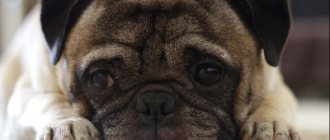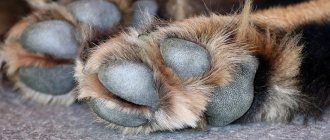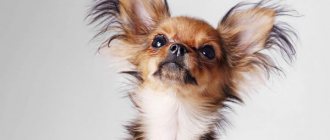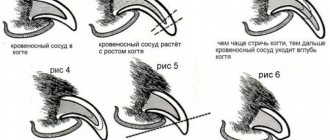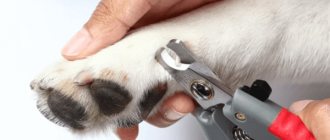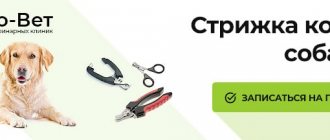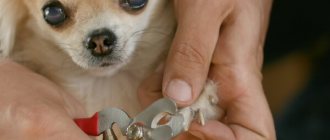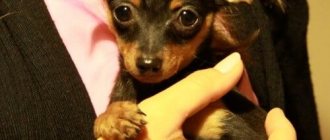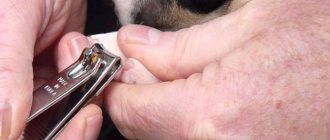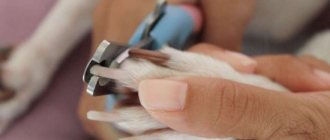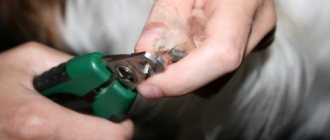How to choose the right tool
There are times when owners, due to inexperience or ignorance, try to trim their dog’s nails with ordinary household scissors. Should not be doing that! Such “cutters” are simply not designed for such cases. Moreover, such pruning can lead to splitting of your pet’s claw.
For dogs in the trade there is a huge selection of nail clippers of 2 rod types:
- guillotine;
- with a sickle-shaped blade.
A tool with a sickle-shaped blade is used for strong nails of large breeds of dogs.
They have two meandering blades and a limiter. A nail cutter with a limiter adjusts the opening of the blades to the size of the claw, which is very convenient. A guillotine-type nail clipper is intended for small and medium-sized dogs. Their structure provides a ring into which you must first insert the claw, and then carefully trim it. The most convenient way to select a nail clipper is directly at the pet store. Since, in addition to the variety, nail clippers also come in different sizes, you should choose this durable and convenient tool with your dog.
For proper selection, you can trim the tip of your pet’s claw and observe whether it has split. The cut must be smooth and even. This goal is achieved if the item with the required steel quality and sharpness is selected correctly. It is recommended to pay attention to the cutting edges of the blades. They should be free of burrs, and you need to make sure that the blades have no noticeable play. It is extremely important to evaluate the reliability and strength of the handles for holding the nail clipper. It is optimal if they are metal with rubberized gaskets in order to prevent the owner’s fingers from slipping.
How to trim a dog's nails
With a nail clipper, you can become proficient in trimming your pet’s nails without nerves and stress for both the owner and the dog. Following the following basic rules will help with this:
- Trimming of nails should begin from the infancy of the pet;
- do not exert pressure or coerce;
- avoid painful sensations;
- choose the moment when your four-legged friend is calm;
- encourage and praise.
It is very important to accustom your dog gradually and slowly to this mandatory procedure. Under no circumstances should this be done forcibly, since the pet’s claws will have to be cut off throughout its entire life. For this reason, it is of great importance that the pet gets used to calmly accepting all manipulations with the nail clipper. First of all, you need to let your pet get acquainted with the nail clipper. To do this, you need to take the dog’s paw, hold it, stroke it, and move it along the claws with a tool.
Slowly increase the amount of time you hold your pet's paw in your hand. Be sure to praise and give a treat upon completion of the procedure.
The same actions are carried out with each paw several times a day. If the dog gets excited and breaks away from your hands, then you should immediately interrupt the lesson. After some time, you need to repeat the manipulation. It makes sense to reduce the time you hold the paw in your hand. Your pet should be rewarded for correct and peaceful behavior. This procedure should not raise negative emotions. It is very important to teach your four-legged friend to allow his paw to be fixed for more than 1 minute without conflict.
Having achieved this, you should proceed to the next step. This stage of training must begin with trimming only one claw, and another time - trim another one. You should not treat all claws at once. After some time, this will be possible, but the main thing is to teach your pet to treat manipulations with the nail clipper without conflict.
What to do if it doesn’t give in and bites
In this case, you can try the following. First, try to calm the dog down and distract it with treats. If you can’t cope on your own, you can ask your loved ones for help. One assistant holds the dog, and the second does the claws.
For each successfully trimmed nail, the pet is given treats.
What to do if it doesn’t give in and bites
Another option is this. The dog is wrapped in a towel. One person holds a pet, and the other cuts a haircut. If you still can’t cope, then you should contact a groomer. Groomers have more experience and will be able to solve the problem.
Instructions for using a nail clipper
When starting the procedure, it is necessary to keep some kind of hemostatic agent and antiseptic nearby each time. The first would be substances such as:
- talc;
- baby powder;
- potassium permanganate, etc.
We sit opposite the light and hold our paw. Gently press on the pad. The claw extends. It needs to be viewed against the light. Even on dark claws it is possible to recognize a blood vessel; on light claws it is diagnosed by its pinkish tint. This is the edge of the stratum corneum that should not be crossed. Carefully begin to cut the claw at right angles to its surface, cutting a little at a time.
Due to the difficulty of finding the exact border of blood vessels on dark claws, you need to be extremely careful and pause the procedure if a dark dot or a light circle appears in the middle of the section, in which the vessels are visible. There's no need to rush. It is safer to trim 1-2 claws at a time with a nail clipper, taking pauses. At the end, it makes sense to trim the cropped edges with a nail file. If you cut too much and touch a nerve, your pet will experience severe pain and will become wary of having its nails trimmed. In this case, it is necessary to take a break, console the pet, treat it with a treat, and play. After one hour, try to cut it again, only this time more carefully.
For the very first time, it makes sense to go to a salon for four-legged friends or to a veterinarian, watch how a professional operates the nail cutter, and then you can cut the claws yourself.
Necessary tools
Before trimming your dog’s nails, you need to stock up on an entire arsenal of useful tools that will be needed during the procedure. You will need:
- scissors;
- grinder or sharpener;
- scratching post;
- cotton pads or tampons.
- antiseptic;
A hair clipper can be purchased at any pet store or veterinary clinic. It is recommended to choose a small rock clamp with a stop. This will help you trim the antlers correctly.
A steel nail clipper is best suited: it does not dull, does not bend, and therefore will not cause discomfort to the animal when cutting.
Scissors are needed for cutting hair between the toes and on the pads of the toes.
A sander is an electric sharpener that must be used to sand down sharp edges after finishing. On sale you can find devices from such brands as Pedi Paws, Master Grooming, Pet Nail Trimmer Grinder.
Electrical scratches can replace the trimming procedure. However, your dog will need to get pedicures more often.
You can replace the grinder with a special sharpener for animals. However, such a tool is less efficient and requires more time for polishing.
As an antiseptic and hemostatic agent for damaged capillaries, use hydrogen peroxide, brilliant green or dry potassium permanganate.
The product is used to cauterize the bleeding area. After the bleeding has stopped, it is recommended to wash off the potassium permanganate so that the animal cannot lick it off.
You can purchase specialized hemostatic agents at the pet store. Bio-Groom Sure Clot Powder has been proven effective among groomers.
First aid for injuries
Most dogs are very worried before trimming their nails, even if they have not experienced negative emotions about this before. One option is relaxation medications. As a rule, sedatives are produced from herbs and weaken nervous excitability, all this gives exactly the effect that is required for a cosmetic procedure. Then prepare special powder, powder or wipes with hemostatic properties. If you cut the claw too deeply, several dozen important vessels will be damaged. Quite often, injuries are accompanied by severe bleeding, and this initiates mutual panic for both dog and owner.
It is important to know that under no circumstances should you treat a damaged claw with the following drugs:
iodine;- fucorcin;
- hydrogen peroxide;
- dimexide;
- alcohol;
- brilliant green;
- vodka.
If you don’t have special powder or baby powder nearby, then ordinary food flour will do. All kinds of cauterizing and alcohol-containing solutions will only increase the pain!
Another rather difficult injury is claw tearing. Most often, this happens if you squeeze the nail clippers for a long time, and the dog suddenly jerks its paw. The secured claw remains in the clamp, and the soft tissue and skin are torn.
The first thing to remember is that this is very painful for the dog! Get ready for your tailed friend to whine loudly and try to run away. Operate quickly enough and without panicking:
- Constantly talk to the dog, console him, do everything in order to distract him from what is happening.
- Intercept the wounded paw with a piece of gauze in the area of the wrist (metatarsus).
- Tighten and secure the gauze thoroughly, while it is recommended to raise the limb as high as possible. Apply cold to the injured paw - ice, a piece of minced meat, frozen vegetables taken from the freezer. Wrap the compress in cotton cloth and cellophane in advance. Cold can help stop blood flow and moderate the pain to some extent.
- Carefully examine the wound, and if there are open tissue tears, fill them with novocaine or lidocaine.
Nail clipper for dogs: selection criteria and rules of use
When a dog is cramped in an apartment or spends a lot of time in a pen with a wooden covering, rushes along paths with pliable soil, or sits in the arms of the owner, the owner should carefully monitor the pet’s paws. It is especially necessary to pay attention to the enlargement of the claws, which grow on your four-legged friend throughout his life. Growing and becoming excessively long, they cause discomfort to the pet and can lead to muscle atrophy and even joint deformation. A pet can get caught in an overgrown claw, which can lead to injury. In other words, a nail clipper is not only a convenient thing, but also simply necessary.
This is interesting: Zhukov Sergey Hands Up
The need for nail clippers
Naturally, claws wear down during fairly long walks on concrete or asphalt. However, this is often not enough. Considerable attention should be paid to the claws on the lateral or dewclaws. The dogs don't reach the ground, so they don't wear off. As the dewclaws grow, they sometimes grow into the skin, causing pain if they are allowed to grow excessively. Under any circumstances, attentive dog owners have a tool that can help keep their pet's paws and claws in perfect order. This is a nail clipper.
How to choose the right tool
There are times when owners, due to inexperience or ignorance, try to trim their dog’s nails with ordinary household scissors. Should not be doing that! Such “cutters” are simply not designed for such cases. Moreover, such pruning can lead to splitting of your pet’s claw.
For dogs in the trade there is a huge selection of nail clippers of 2 rod types:
- guillotine;
- with a sickle-shaped blade.
A tool with a sickle-shaped blade is used for strong nails of large breeds of dogs. They have two meandering blades and a limiter. A nail cutter with a limiter adjusts the opening of the blades to the size of the claw, which is very convenient.
A guillotine-type nail clipper is intended for small and medium-sized dogs. Their structure provides a ring into which you must first insert the claw, and then carefully trim it. The most convenient way to select a nail clipper is directly at the pet store. Since, in addition to the variety, nail clippers also come in different sizes, you should choose this durable and convenient tool with your dog.
For proper selection, you can trim the tip of your pet’s claw and observe whether it has split. The cut must be smooth and even . This goal is achieved if the item with the required steel quality and sharpness is selected correctly. It is recommended to pay attention to the cutting edges of the blades. They should be free of burrs, and you need to make sure that the blades have no noticeable play. It is extremely important to evaluate the reliability and strength of the handles for holding the nail clipper. It is optimal if they are metal with rubberized gaskets in order to prevent the owner’s fingers from slipping.
Reviews
About two years ago I ordered nail clippers. My friends also ordered the same big one for a Labrador. My dog is no longer afraid of the manicures I give her. The nail cutter cuts like clockwork and does not break the claw. The cut is always straight. The rubber handles are very comfortable, there is a lock and a limiter.
Masha
I now have two dogs - an adult Yorkie and a Chihuahua puppy. She chose the claw cutter herself and held it in her hand. A small dog doesn't need a big nail clipper. For Yorkies I use a guillotine. Then I process it with a file, then the claws turn out more even.
If you accidentally cut a claw until it bleeds, immediately sprinkle it with dry potassium permanganate.
Tasya
We use a nail clipper - a guillotine, as in the picture, from Trixie.
Serves for more than ten years. The dogs are medium-sized - a German Shepherd and a medium-sized mongrel. Alina
How to trim a dog's nails
With a nail clipper, you can become proficient in trimming your pet’s nails without nerves and stress for both the owner and the dog. Following the following basic rules will help with this:
- Trimming of nails should begin from the infancy of the pet;
- do not exert pressure or coerce;
- avoid painful sensations;
- choose the moment when your four-legged friend is calm;
- encourage and praise.
It is very important to accustom your dog gradually and slowly to this mandatory procedure. Under no circumstances should this be done forcibly, since the pet’s claws will have to be cut off throughout its entire life. For this reason, it is of great importance that the pet gets used to calmly accepting all manipulations with the nail clipper. First of all, you need to let your pet get acquainted with the nail clipper. To do this, you need to take the dog’s paw, hold it, stroke it, and move it along the claws with a tool.
Slowly increase the amount of time you hold your pet's paw in your hand. Be sure to praise and give a treat upon completion of the procedure.
The same actions are carried out with each paw several times a day. If the dog gets excited and breaks away from your hands, then you should immediately interrupt the lesson. After some time, you need to repeat the manipulation . It makes sense to reduce the time you hold the paw in your hand . Your pet should be rewarded for correct and peaceful behavior. This procedure should not raise negative emotions. It is very important to teach your four-legged friend to allow his paw to be fixed for more than 1 minute without conflict.
Having achieved this, you should proceed to the next step. This stage of training must begin with trimming only one claw, and another time - trim another one. You should not treat all claws at once. After some time, this will be possible, but the main thing is to teach your pet to treat manipulations with the nail clipper without conflict.
The process of trimming Yorkie's nails step by step
So, the haircut procedure is not very difficult. First you need to prepare the dog's paws. They are washed in warm water. Then they start cutting.
You need to act quickly and carefully. It is very important to remain calm and not get nervous, otherwise the dog will become nervous.
After finishing the haircut, use a nail file to polish the remaining part of the claw. This is necessary to ensure that the pet does not harm itself or scratch the floor or furniture.
A nail clipper has a lot of conveniences, but it also has disadvantages. The cut is sharp and uneven. Claws after such treatment require additional processing. You can purchase a special grinding stone. Of course, it is more convenient to cut, but you can simply trim the length.
The pet may react to this with displeasure. Because the grinding process is longer and takes more time.
What method to shorten the nails to choose is decided mutually by the dog owner. And, of course, the pet itself.
Instructions for using a nail clipper
When starting the procedure, it is necessary to keep some kind of hemostatic agent and antiseptic . The first would be substances such as:
- talc;
- baby powder;
- potassium permanganate, etc.
We sit opposite the light and hold our paw. Gently press on the pad. The claw extends. It needs to be viewed against the light. Even on dark claws it is possible to recognize a blood vessel; on light claws it is diagnosed by its pinkish tint. This is the edge of the stratum corneum that should not be crossed. Carefully begin to cut the claw at right angles to its surface, cutting a little at a time.
Due to the difficulty of finding the exact border of blood vessels on dark claws, you need to be extremely careful and pause the procedure if a dark dot or a light circle appears in the middle of the section, in which the vessels are visible. There's no need to rush. It is safer to trim 1-2 claws at a time with a nail clipper, taking pauses. At the end, it makes sense to trim the cropped edges with a nail file. If you cut too much and touch a nerve, your pet will experience severe pain and will become wary of having its nails trimmed. In this case, it is necessary to take a break, console the pet, treat it with a treat, and play. After one hour, try to cut it again, only this time more carefully.
For the very first time, it makes sense to go to a salon for four-legged friends or to a veterinarian, watch how a professional operates the nail cutter, and then you can cut the claws yourself.
Yorkie claw structure
Yorkie claw structure
A dog's claws consist of several parts:
- The outside of the claw is hard;
- Inside there is a soft layer - pulp.
The pulp area contains a large number of thin blood vessels. As the claw grows, all layers increase simultaneously.
The first picture shows schematically the structure of a dog's claw:
A). Pulp;
B). Hard part (dead tissue).
The second picture shows what happens to the claw if it is not shortened for a long time. Without regular trimming, living tissue begins to fill the entire claw. Its length makes it difficult to step on the paw with all your weight. As a result, the center of gravity shifts, which leads to improper functioning of the joints.
The claw itself consists of two layers:
- Keratin coating;
- Nail bed area.
While there are no nerve endings in the keratin layer, there are many of them in the nail bed. In addition, at the base of the claw there are capillaries and blood vessels. You need to handle them very carefully. If you damage them, you can seriously harm your pet.
First aid for injuries
Most dogs are very worried before trimming their nails , even if they have not experienced negative emotions about this before. One option is relaxation medications. As a rule, sedatives are produced from herbs and weaken nervous excitability, all this gives exactly the effect that is required for a cosmetic procedure. Then prepare special powder, powder or wipes with hemostatic properties. If you cut the claw too deeply, several dozen important vessels will be damaged. Quite often, injuries are accompanied by severe bleeding, and this initiates mutual panic for both dog and owner.
It is important to know that under no circumstances should you treat a damaged claw with the following drugs:
iodine;- fucorcin;
- hydrogen peroxide;
- dimexide;
- alcohol;
- brilliant green;
- vodka.
If you don’t have special powder or baby powder nearby, then ordinary food flour will do. All kinds of cauterizing and alcohol-containing solutions will only increase the pain!
Another rather difficult injury is claw tearing . Most often, this happens if you squeeze the nail clippers for a long time, and the dog suddenly jerks its paw. The secured claw remains in the clamp, and the soft tissue and skin are torn.
The first thing to remember is that this is very painful for the dog! Get ready for your tailed friend to whine loudly and try to run away. Operate quickly enough and without panicking:
- Constantly talk to the dog, console him, do everything in order to distract him from what is happening.
- Intercept the wounded paw with a piece of gauze in the area of the wrist (metatarsus).
- Tighten and secure the gauze thoroughly, while it is recommended to raise the limb as high as possible. Apply cold to the injured paw - ice, a piece of minced meat, frozen vegetables taken from the freezer. Wrap the compress in cotton cloth and cellophane in advance. Cold can help stop blood flow and moderate the pain to some extent.
- Carefully examine the wound, and if there are open tissue tears, fill them with novocaine or lidocaine.
Tool cost
Regarding the question of how much nail clippers and scissors for trimming dog nails cost , here it is worth starting from the size of your pet.
Any pet store has an impressive assortment of nail clippers. You can also place an order through online stores, and then they will deliver it to your home. The cost of the tools directly depends on the type and size of your dog. As a rule, a nail clipper or scissors for small dog nails can be purchased for 250-400 rubles. For larger animals, the purchase will cost approximately 550-700 rubles. The sales consultant can advise which of them is better to choose.
If necessary?
The answer to the question of whether dogs need to have their nails trimmed is definitely positive. And Spitz are no exception. These cute, fluffy and miniature dogs always delight others with their appearance. But it’s not just wool that requires attention.
Spitz dogs need to have their nails trimmed periodically. They simply do not have time to wear down, despite the dog’s frequent walks and activity. If the claws grow, they lead to discomfort: it becomes uncomfortable and painful for the dog to walk, lameness may appear and, as a result, problems with the joints.
How to trim a dog's nails. Step-by-step instruction
Not every four-legged pet easily tolerates the process of trimming its nails. Most dogs experience discomfort and try in every possible way to avoid this procedure. But the owner must understand that if the dog does not spend most of his time outside, then claw trimming is indispensable.
This is interesting: Maria Anna Aleksandrovna Balueva
Content:
Most owners prefer going to a specialized clinic. There is an opinion that it is impossible to perform the procedure on your own and you should trust only a veterinarian.
In fact, the situation is somewhat different. Any owner can easily trim his pet's nails himself. To do this, you just need to familiarize yourself with the theory, purchase the right tool and practice a little.
Hygiene procedures
All pets need proper care. This will improve your pet's health and extend its life.
Procedures necessary for a dog include:
- Bathing allows you to keep the animal's fur clean;
- Combing. Promotes smooth and silky fur;
- Teeth cleaning. Dogs are susceptible to dental disease, so it is important to brush your dog's teeth at least once every two days;
- Nail trimming. Necessary to prevent nails from growing into pillows.
It is best to entrust the cutting of dog nails to a professional: a Veterinarian or a groomer.
But, if it is not possible to contact a specialist, then you can cut your nails yourself, at home. The process of cutting nails is not complicated, although it does require certain knowledge and preparation.
Why trim dogs' nails?
Long gone are the dogs that accompanied their owner every day on hunts, on pastures and on long walks.
Most city animals go out for walks only for short periods of time. And most of the day they lie on cozy bedding, comfortable armchairs and sofas, and smooth parquet or laminate flooring does not contribute to grinding the claws down to a physiologically correct state.
As a result, the claws continue to grow and after a short time they begin to:
- Cause discomfort when moving. Due to overgrown claws, the dog places his paw incorrectly, trying to ease the pain. This causes curvature of the joints and uneven load on the musculoskeletal system. Gradually, the animal’s gait becomes irregular and running becomes difficult;
- It is no secret to owners that dogs have a 5th toe on their hind legs. Some people immediately remove it while still a puppy. But many people ignore and do not attach importance to the fact that a growing claw must be trimmed. Otherwise, it grows and begins to cling to bedspreads or capes. And when walking it causes discomfort. In some cases, when running or moving quickly, the claw catches on objects. As a result, the dog can tear soft tissues or severely break off a claw;
- In some cases, overgrown claws can grow in and cause additional pain and discomfort to your four-legged pet;
- Stress and misunderstanding. Strongly overgrown claws make loud noises when the dog moves on laminate, parquet or other surfaces. This creates particular discomfort at night, and the owner may not be able to restrain himself and scold the four-legged pet who simply approached the bowl to drink.
This is important: Experts recommend consulting with your veterinarian before embarking on nail trimming. A specialist will help you determine the optimal length and tell you how to correctly perform the procedure.
How to train a dog to trim its nails
Experienced dog handlers and veterinarians claim that there is no difficulty in the procedure itself. Accustoming the dog to it becomes a much more serious test for the owner’s nervous system. Not every pet is ready to calmly react to this manipulation. Therefore, the training process is of great importance.
Dog handlers recommend getting down to business only in a calm state. If the owner is excited, nervous or angry, then his mood is instantly transmitted to the dog. The dog does not understand what is causing this condition, but he becomes unbalanced, refuses to sit still, pulls his paw out of his hands, and trimming his claws will be very difficult.
It should be taught gradually. This is the basic principle. If the dog is calm and relaxed, then you should take his paw and, after trying it on, trim one claw. Don't insist or force. If everything is done correctly, the pet will not even be wary. Praise generously and trim another nail the next day.
A slightly different situation arises if you become the owner of an adult animal that begins to get nervous at the sight of a nail clipper and flatly refuses to give its paw.
In this case, veterinarians recommend following a certain algorithm:
- Prepare the instrument and let the animal sniff it. After that, put everything in the box;
- When the sight of a nail clipper, nail file and other devices stops making the animal nervous, you should move on to the next phase;
- Teach your pet to give his paw on command and then touch it with a nail clipper. The dog must get used to the idea that there is nothing scary in this procedure;
- Immediately before trimming, you should sterilize the tool, treat your hands and inspect the dog’s paws;
- If the pet sits quietly, then it is necessary to trim one claw. It is important not to cause him pain or discomfort. Afterwards you need to give a treat and praise; The next day, the procedure is repeated with one claw.
This is important: The entire manipulation of trimming claws on 4 paws will initially take quite a lot of time. But as soon as the animal gets used to it, it will be possible to do it at once.
How often should a dog's nails be trimmed?
Veterinarians do not give a clear answer to this question. The frequency of the procedure directly depends on the dog’s lifestyle, as well as on the surface on which it moves.
If your four-legged pet lives in comfortable apartment conditions, uses a litter tray and moves only on parquet or laminate flooring, then it is necessary to trim its nails quite often. And if the dog leads an active lifestyle, spends a lot of time in the yard, walks and accompanies its owner everywhere, then the procedure should be performed much less frequently. After all, the claws wear down naturally and only sometimes does it become necessary to make corrections.
Veterinarians remind that there are blood vessels inside the claw. The longer the claw grows, the longer the blood vessel will be. Therefore, it is so important for the owner to prevent it from growing to excessive length. In this case, it will no longer be possible to adjust the length without the risk of damaging the vessel. This is directly associated with pain and discomfort for the pet.
If your hand trembled?
Even an experienced groomer can touch living tissue and damage a blood vessel, let alone the owner of the Spitz. There's nothing wrong with that. The wound must be immediately treated with any antiseptic. Then you need to hold it for a few seconds with a cotton swab containing potassium permanganate. If the bleeding cannot be stopped, the dog is immediately sent to a veterinary clinic for qualified assistance.
Nail trimming tools
Dog handlers recommend not using classic scissors or nippers when correcting claws.
At a veterinary pharmacy or specialty store, you should purchase a tool called a nail clipper. With its help, with one click you can cut off the required length without the risk of damaging the claw or splitting it. The size of the tool should be selected taking into account the breed of the dog.
Currently, only two types of nail clippers can be found on the shelves of veterinary pharmacies and specialized stores:
- Scissors. This design has two blades, one of which is bent into a hook, and two handles. Some models are equipped with a limiter;
- Guillotine. The models differ in one plate, which has a hole for the claw, and are also equipped with a lever handle.
This is important: You should also have a nail file in your arsenal with which you can file a claw. As well as small scissors with rounded edges for removing hair between the fingers.
How to trim nails correctly
In order for the pet to undergo the nail trimming procedure with minimal discomfort, the owner should remember a few rules:
- Preliminary inspection of paws. The presence of cracks, wounds, damage to the pads or delamination of the nail indicate the need to visit a veterinarian to prescribe a course of treatment;
- Black claws are the most difficult option to trim. Light or beige ones allow you to see the pulp and make the procedure much easier. The pulp is a darkened area containing blood vessels;
- Place your pet's paw on the floor. The nail cutter should be positioned at an angle of 450 and not reach 1-1.5 mm to the beginning of the pulp. The maximum step for cutting is no more than 0.5 cm;
- For animals with black claws, the procedure will have to be performed very carefully and no more than 0.5 cm for each cut. If lighter areas of the claw appear, you should stop.
This is important: In some cases, a guideline for the approximate location of the pulp in an animal with black claws can be the hollow located on the lateral surface. Veterinarians recommend focusing on it and trimming carefully, leaving the claw somewhat longer.
Proper execution at home
Trimming a Spitz's nails yourself is a fairly simple process if you prepare for it correctly. First, you need to prepare all the necessary tools:
- a guillotine-type nail clipper with rubberized metal handles so that it does not slip in your hands;
- a regular nail file with a large coating;
- cotton pads;
- antiseptic (alcohol, chlorhexidine, hydrogen peroxide);
- hemostatic agents: talc or potassium permanganate powder (preferably in a bottle for ease of use).
Secondly, the work place should be well lit. The Spitz can be placed on a table, the floor, or simply placed on your lap.
Thirdly, you need to trim the long hair on the pads and between the toes. This will make further work much easier.
When all the necessary tools are ready, you can proceed directly to the haircut. Press on the pad to make the claw easier to see. In the light, determine where the horny part ends (it will be lighter than the living part). Cut the tip about 1 millimeter at an angle of 45 towards the inside of the foot.
Once the process is complete, polish the claw with a nail file.
First aid for injuries
Even experienced owners may experience situations where the pruning procedure becomes stressful. This could be due to a huge number of factors, ranging from a dull instrument to a sharp sound outside the window that frightened the pet.
It is important to remain calm and clearly understand the algorithm of actions in the event of an injury.
Pulp trauma
If the pruning is done too short, there is a high risk of damaging a large number of blood vessels. In this case, heavy bleeding and sharp pain occur;
This is interesting: Which Fingers Wear Rings On?
It is the owner's job to stop the bleeding and calm the dog. Try to distract your pet. You should not shout at him, because the animal is in severe pain;
Using brilliant green, an alcohol solution of iodine, or other alcohol-containing antiseptics will only increase the pain. Therefore, many breeders prefer to treat open wounds with antiseptic powder.
You might find our article useful: Home veterinary first aid kit for dogs
This is important: If an injury occurs, and the first aid kit does not have the necessary medications, then experts advise stopping the bleeding with the help of flour.
Claw detonation
This situation arises in case of uncertain actions of the owner. Slow squeezing of the nail clipper by the owner in combination with a sharp jerk of the paw at the moment of manipulation can lead to disastrous results.
As a result, the claw becomes caught in the instrument and the skin and soft tissues rupture. The owner should:
- Remember that this is very painful for your four-legged pet. Therefore, he will try to break free and run away;
- The injured limb should be bandaged with gauze or a tourniquet in the metatarsal area; Raise the limb upward to stop bleeding;
- Apply cold to the injured paw. This could be an ice pack, food or fruit from the freezer;
- Open lesions should be treated with lidocaine. In its absence, this drug can be replaced with novocaine;
- If the wound is too large or the gap needs to be stitched, you should immediately seek help from a veterinarian.
This is important: before you remove frozen food from the freezer, place it in a bag and then wrap it in a towel or cloth. This will help avoid hypothermia. Also, you should not hold the cold on the injured limb for long to avoid frostbite.
The owner should remember that if an injury occurs, the dog must be left alone and not continue the nail trimming procedure for a period of 5-10 days.
What if it's broken?
If you suddenly notice that your pet has begun to limp, refuses to run and constantly licks its paw, most likely it has broken a claw. What to do in this case?
On the edge
First of all, it is important to determine the extent of damage to the claw. If only the cornea is broken, then there is nothing to worry about. Just trim the bumps and file the nail.
At the base
If the pulp is damaged and bleeding comes from the wound, then you need to take immediate action - stop the bleeding with hydrogen peroxide and a cotton pad.
Then you need to lubricate the damaged area with iodine or brilliant green and bandage it (put on a sock), and put a bag on top to avoid infection. It is not recommended to trim the claw in this situation!
If the bleeding cannot be stopped for more than 10 minutes or the Spitz simply does not allow it to be done (bites, breaks out or does not give its paw), you must take the pet to the veterinarian. He will be able to assess the extent of damage and prescribe the correct treatment.
